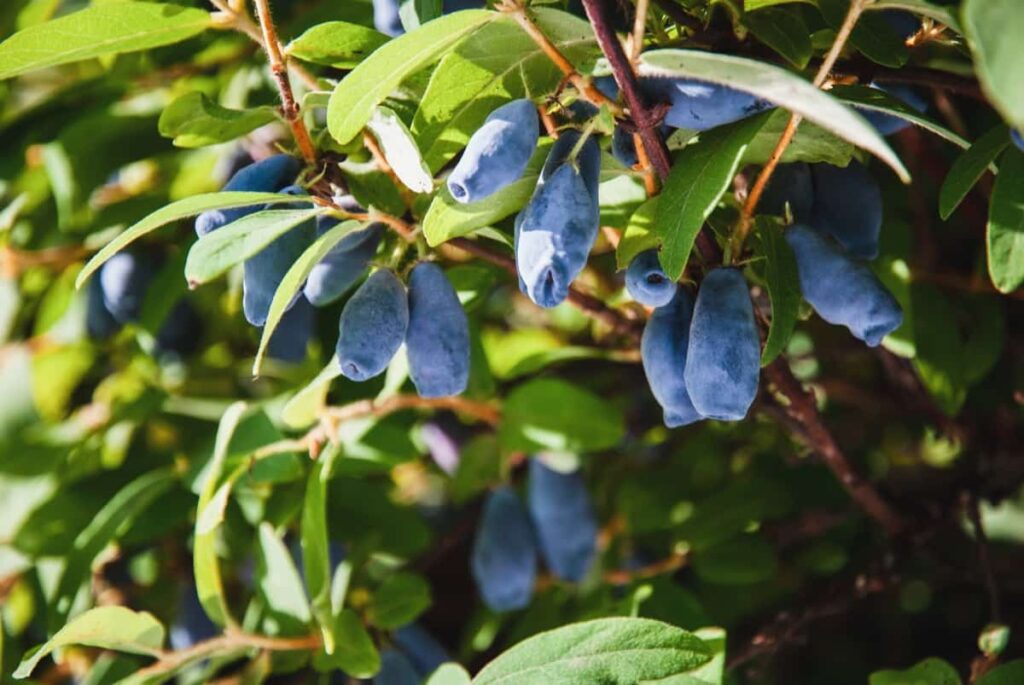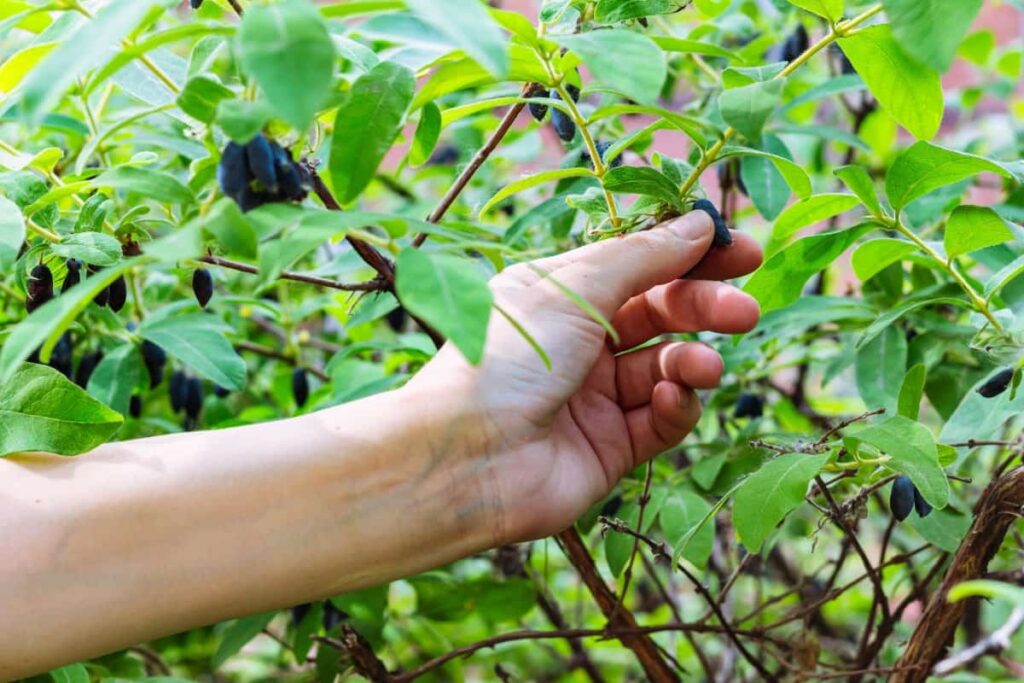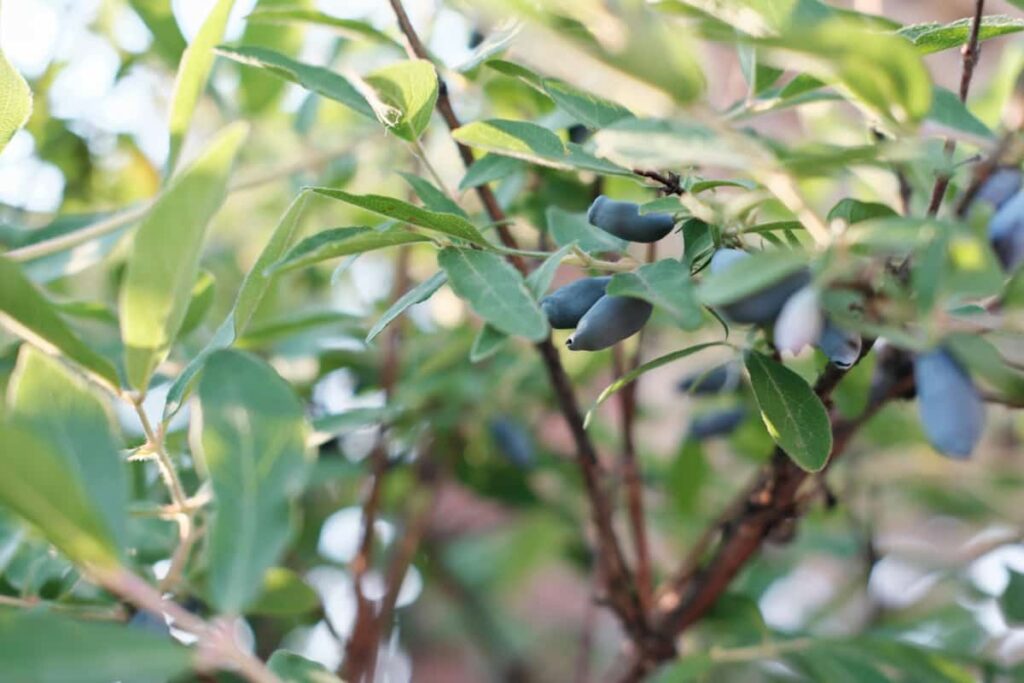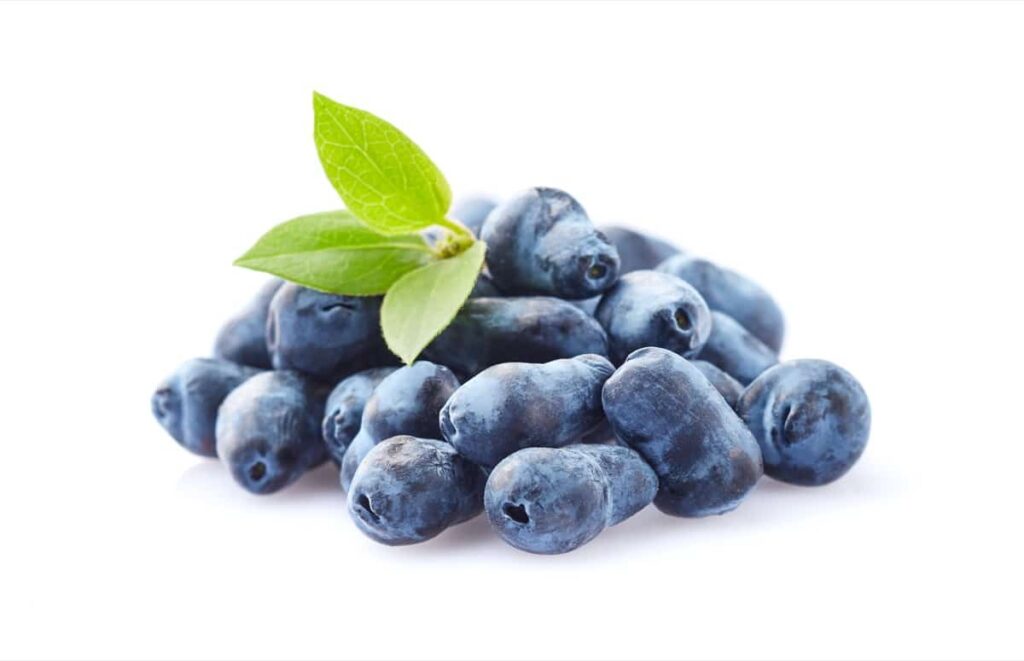Honeyberries are small fruits that resemble elongated blueberries. Native to northern regions such as Russia and Japan, they have recently gained popularity for their delicious taste and numerous health benefits. To ensure successful growth of your honeyberry plants, it’s important to provide adequate sunlight and regular watering during dry spells.

17 Honeyberry Varieties
Aurora Honeyberries
Aurora Honeyberries are among the most popular Honeyberry varieties in your garden. With their vibrant orange color, they add a pop of brightness to any fruit salad or dessert. Firstly, plant them in well-draining soil with plenty of organic matter. Pruning is another important aspect of caring for Aurora Honeyberries. Prune them annually in early spring before new growth begins. This will help promote better airflow and reduce the risk of disease.
Borealis Honeyberries
Borealis Honeyberries are a popular cultivar among gardeners, known for their deliciously sweet and tangy flavor. These berries have a deep blue color and are packed with antioxidants, making them a healthy addition to any diet. Make sure to plant them in well-drained soil rich in organic matter.
Providing adequate water during the growing season is important to ensure optimal growth and fruit production. Regular watering will help prevent the berries from drying out or becoming too tart. Pruning is also essential when it comes to maintaining healthy Borealis Honeyberry plants. It’s best to prune them in early spring before new growth begins. This will help promote airflow and prevent diseases. With its compact size, Borealis is ideal for smaller gardens or even container planting on balconies or patios.
Cinderella Honeyberries
Cinderella Honeyberries are a delightful addition to any garden. These beautiful berries have a unique flavor that combines sweetness with a hint of tartness, making them a good addition to your favorite recipes. One of the best things about Cinderella Honeyberries is their versatility. Their vibrant blue color adds a pop of beauty to any dish. Make sure they are planted in well-drained soil that receives full sun. These berries thrive in cooler climates and can tolerate frost, so they’re ideal for northern gardens.
In case you missed it: Berry Orchard Management: Essential Month-wise Maintenance Guide

Pruning is also important when it comes to maintaining healthy Cinderella Honeyberry plants. Regular pruning helps promote new growth and ensures optimal fruit production. It’s recommended to prune these bushes during the late winter or early spring before new growth begins. In terms of care, Cinderella Honeyberries require regular watering but should not be overwatered in the honeyberry plant as this can lead to root rot. Mulching around the plant base can help retain moisture while preventing weeds from taking over.
Tundra Honeyberries
Tundra Honeyberries are a fantastic addition to any garden. These small blueberries pack a punch regarding flavor and nutrition. They have a sweet yet tangy taste reminiscent of blueberries and raspberries. One of the great things about Tundra Honeyberries is their cold hardiness. They can withstand even the harshest winters, making them an excellent gardener choice. This means you can enjoy fresh honeyberries from your garden, even during those chilly months.
When growing Tundra Honeyberries, it’s important to provide them with full sun exposure. These plants thrive in slightly acidic soil conditions, so adding organic matter like compost or peat moss can help create the perfect growing environment. Tundra Honeyberry bushes are also self-pollinating, which makes them ideal for smaller gardens where space may be limited. However, planting multiple varieties nearby can further enhance pollination and increase fruit production.
Indigo Gem Honeyberries
Indigo Gem Honeyberries are a popular honeyberry variety known for their vibrant blue color and delicious flavor. To ensure successful growth, it’s important to plant Indigo Gem Honeyberries in an area with full sun exposure. They require at least six hours of direct sunlight daily to produce abundant fruit.
In case you missed it: 15 Best Varieties of Dragon Fruit: DifferentTypes of Dragon Fruit (Pitaya) to Grow

Additionally, make sure to provide them with well-drained soil and regular watering. Depending on your location, these berries ripen in late spring or early summer. When fully ripe, they have a deep blue color that is simply stunning. The berries can be harvested by gently plucking them from the branches when they easily come off without resistance.
Indigo Treat Honeyberries
Indigo Treat Honeyberries are a delightful addition to any garden. One of the great things about Indigo Treat Honeyberries is that they are incredibly easy to grow. They thrive in various climates, from cool temperate regions to colder areas with harsh winters. This makes them an ideal choice for gardeners who live in northern climates where other fruit may struggle to survive. To start growing Indigo Treat Honeyberries, choose a sunny location in your garden with well-draining soil.
These plants prefer slightly acidic soil, so if your soil is too alkaline, you may need to amend it before planting. It’s also important to note that Indigo Treat Honeyberries require cross-pollination from another honeyberry variety to bear fruit, so be sure to plant at least two varieties within proximity. Once planted, regularly water your Indigo Treat Honeyberry plants and provide them with some organic fertilizer every spring. Prune them lightly each year after harvest to maintain their shape and encourage new growth.
Berry Blue Honeyberries
Berry Blue Honeyberries are a popular variety of honeyberry that is known for its vibrant blue color and delicious flavor. These berries have a sweet-tart taste reminiscent of blueberries but with a unique twist. They are perfect for eating fresh, adding to salads or desserts. One of the great things about growing Berry Blue Honeyberries in your garden is that they are relatively easy to care for. It’s also important to ensure they receive adequate water, especially during dry periods.
When planting Berry Blue Honeyberries, it’s best to space them about 3-4 feet apart to allow room for growth. Pruning is also important for maintaining the health and productivity of the plants. Depending on your location, these honeyberries ripen in late spring or early summer. When the berries turn a deep blue color and feel slightly soft when gently squeezed, they are ready to be harvested.
Blue Moon Honeyberries
Blue Moon Honeyberries are a delightful addition to any garden. These unique berries have a beautiful blue color and a sweet, tangy flavor that will surely please your taste buds. They are also packed with antioxidants and vitamins, making them a healthy choice for adding to your favorite recipes. When growing Blue Moon Honeyberries in your garden, choosing a place that receives full sun or partial shade is important.
In case you missed it: 19 Best Cucumbers for Pickling: Top Crunchy Varieties to Grow in Your Garden

They prefer well-drained soil with a pH level between 5.0 and 7.0. Pruning is an essential part of caring for Blue Moon Honeyberries. It helps promote better air circulation and prevents the spread of diseases. Remove dead or damaged branches in early spring and thin out crowded areas. Harvesting Blue Moon Honeyberries is exciting! The berries start green, then gradually turn blue when they are ripe and ready to be picked.
Blue Velvet Honeyberries
Blue Velvet Honeyberries are a stunning variety that will add beauty to your garden. With their deep blue color and velvety texture, these berries are as beautiful as they are delicious. One of the great things about Blue Velvet Honeyberries is their versatility. They can be enjoyed fresh off the bush, added to salads or smoothies, or used in jams and desserts.
Their unique flavor is sweet and tangy, making them a delightful addition to any recipe. When growing Blue Velvet Honeyberries, they thrive in well-drained soil. These honeyberries are known for their hardiness and ability to withstand cold temperatures. They are perfect for colder climates where other fruits may struggle. You can enjoy an abundant harvest of Blue Velvet Honeyberries year after year.
Blue Pagoda Honeyberries
Blue Pagoda Honeyberries are a delightful addition to any garden. With their striking blue color and sweet, tangy flavor, these berries will surely please your taste buds. These berries thrive in well-drained soil that is rich in organic matter. It’s important to provide them with regular water during the growing season, especially during dry spells.
Pruning is an important part of maintaining healthy Blue Pagoda Honeyberry plants. Prune them in late winter or early spring before new growth appears. Harvesting Blue Pagoda Honeyberries is an exciting time. The berries should be picked when they turn deep blue and have a slight give when gently squeezed. Enjoy them fresh off the bush, or use them in jams, pies, or smoothies for a burst of flavor.
Blue Sea Honeyberries
Blue Sea Honeyberries are a delightful variety to add to your garden. These berries thrive in cooler climates, making them perfect for those who live in northern regions. They prefer well-drained, slightly acidic soil. Adding compost or peat moss can help improve the soil quality if needed. Planting Blue Sea Honeyberry bushes at least 6 feet apart is important to allow air circulation and prevent diseases. To ensure a good harvest of Blue Sea Honeyberries, make sure they receive full sun or partial shade throughout the day.
Blue Pacific Honeyberries
Blue Pacific Honeyberries are a delicious and nutritious addition to any garden. When growing Blue Pacific Honeyberries in your garden, choosing a sunny place with well-drained soil is important. These Honeyberry plants thrive in full sun but can tolerate some light shade. It’s also important to ensure they have enough space to spread out, as they can grow up to 5 feet tall. To ensure the best harvest, it’s recommended that you plant multiple Blue Pacific Honeyberry bushes. This will increase pollination and give you a larger yield of berries.
In case you missed it: Growing Jackfruit in the Philipines: A Guide to Varieties, Propagation Methods, and Care

The best time to plant these bushes is in early spring or fall when the weather is cool. Once your Blue Pacific Honeyberry bushes are established, water them regularly and mulch around the base of the plants to help retain moisture. Pruning is important for maintaining healthy growth and encouraging fruit production. Blue Pacific Honeyberries are an excellent choice for gardeners looking for something unique and flavorful.
Blue Belle Honeyberries
Blue Belle Honeyberries are a fantastic addition to any garden. One of the great things about Blue Belle Honeyberries is that they are relatively easy to grow. When planting Blue Belle Honeyberries, ensuring enough space to grow is important. These Honeyberry plants can reach heights of up to 5 feet, so ensure you give them plenty of room in your garden bed or container. Blue Belle Honeyberries require regular watering and fertilizing during the growing season. It’s also important to prune them annually to promote healthy growth and maintain their shape.
Blue Lagoon Honeyberries
Blue Lagoon Honeyberries are a delightful addition to any garden. One of the great things about Blue Lagoon Honeyberries is that they are relatively easy to grow. They thrive in colder climates, making them a perfect choice for those living in northern regions. Make sure you select a sunny place with well-draining soil. These berries prefer slightly acidic soil, so adding compost or peat moss can help create the ideal growing conditions. Once your Blue Lagoon Honeyberry bushes are established, you’ll be rewarded with abundant, delicious fruit.
Blue Forest Honeyberries
Blue Forest Honeyberries are a delightful addition to any garden. With their vibrant blue color and sweet, tangy flavor, these berries will surely please your taste buds. They get their name from the dense forest-like growth of the plants, creating a beautiful and lush display in your garden. One of the great things about Blue Forest Honeyberries is that they are relatively easy to grow.
They can tolerate many soil conditions and are quite hardy, making them suitable for many climates. However, they do prefer full sun or partial shade for optimal growth. Regular watering is important during dry spells when caring for Blue Forest Honeyberries. Pruning is also necessary to maintain healthy growth and encourage fruit production.
Blue Bird Honeyberries
Blue Bird Honeyberries are a delightful variety that will add color and flavor to your garden. These berries have a vibrant blue skin with a sweet, tangy taste that will surely please your palate. One of the great things about Blue Bird Honeyberries is their versatility. They can be enjoyed fresh off the bush or used in jams, jellies, pies, and other delicious treats. Their unique flavor profile adds depth and complexity to any recipe.
Make sure you choose a location with full sun or partial shade for optimal growth. These berries thrive in well-draining soil that is rich in organic matter. Another important tip is to provide adequate water for your Blue Bird Honeyberry plants. Pruning is also an essential part of caring for Blue Bird Honeyberries. Regular pruning helps maintain plant health and shape while encouraging new growth and maximizing berry production.
Blue Diamond Honeyberries
These plants thrive in well-drained soil and prefer full sun or partial shade. They are also quite hardy and can withstand colder temperatures than other varieties. Regular pruning is essential for Blue Diamond honeyberry plants to ensure optimal growth and fruit production. This helps maintain their shape and encourages new growth each year. Providing adequate water during dry spells will help these plants stay healthy and productive. The berries ripen gradually over several weeks, allowing you to savor them at different stages of maturity.
In case you missed it: Key Rules to Grow Organic Mangoes in Uttarpradesh: Varieties, Cultivation Practices, and Production Management

Conclusion
Honeyberry plants are relatively easy to grow. They’re hardy bushes that can tolerate various climates and soil conditions. Whether you live in a cold northern region or a mild coastal area, you can enjoy the fruits of your labor by cultivating these beauties in your backyard.
- Sheep Farming Business Plan for Beginners
- Aquaponic Farming at Home: A Step-By-Step Guide
- Profitable Village Farming Business Ideas in 2024
- High-Yield Aquaculture: Fast-Growing Fish for Farming
- Effective Fish Pond Construction Techniques for Beginners
- Irrigation and Water Management in Pineapple Farming
- Blossom to Harvest: Mastering Flowering and Pollination in Papaya Farming
- Pig Fattening Essentials: From Selection to Sale for Beginners
- Raising Wagyu Cattle: A Complete Guide for Premium Beef Production
- Soil Types and Their Water Holding Capacity
- Optimizing Irrigation Schedules for Coconut Groves for Enhanced Yield
- Espresso Your Garden: Coffee Grounds for Healthier Acid-Loving Plants
- The Best Soil Mix for Snake Plants: How to Mix Your Own Snake Plant Soil
- Green Thumb Success: Expert Tips for Cultivating Greenhouse Beans All Year Round
- Bloom All Year Round: The Ultimate Guide to Indoor Hyacinth Care
- Eco-Friendly Gardening: How to Make Liquid Fertilizer from Kitchen Waste
- Ultimate Guide to Grow Anise in Pots: Explore Seed Propagation to Harvesting
- Guide to Raising Chester White Pigs: Discover Breed Facts to Growth Management
- Mastering the Elegance: The Ultimate Guide to Weeping Cherry Tree Care, Planting, and Maintenance
- Ultimate Guide to Planting Garlic in Grow Bags: Growing Strategies for Beginners
- How to Fix Spider Plant Leaf-Related Problems: Natural and Organic Remedies
- 10 Reasons Why Your Tulsi Plant is Shedding Leaves: Home Remedies and Solutions
- Optimizing Growth and Yield: The Advantages of Palm Bunch Ash Fertilizer
- Utilizing Neem Oil Extract as a Natural Pesticide for Hydrangea
- From Soil to Harvest: Various Ways in Which Farmers Can Use AI Tools
- Steps to Encourage and Induce Citrus Flowers: A Comprehensive Guide
- How to Fix Snake Plant Leaf-Related Issues: Natural and Organic Remedies
- Transform Your Garden into a Fragrant Oasis with Raat Ki Rani (Night Blooming Jasmine)
- Discover the Ideal Chicken Breeds for Philippine Farms
- How to Create a Poultry Egg Farm Business Plan for Profits
- Grow Lemon Cucumbers Like a Pro: Insider Techniques for Bountiful Yields
- Ultimate Guide to Caring for Your Pink Princess Philodendron: Tips for Thriving Variegation
- Areca Nut Profit Per Acre: Calculating Yield and Cost of Cultivation
- How Kaveri Chicken is Becoming a More Profitable Breed in Indian Backyards
- Transform Your Barn: 9 Steps to Convert a Horse Stall into a Chicken Coop
- Exploring Suffolk Sheep Disadvantages with Limitations and Challenges
